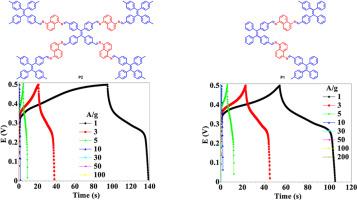Our official English website, www.x-mol.net, welcomes your
feedback! (Note: you will need to create a separate account there.)
Conjugated tetraphenylethene-based polymers for supercapacitor
Polymer ( IF 4.1 ) Pub Date : 2024-11-09 , DOI: 10.1016/j.polymer.2024.127778 Abdelreheem Abdelfatah Saddik, Hani Nasser Abdelhamid
Polymer ( IF 4.1 ) Pub Date : 2024-11-09 , DOI: 10.1016/j.polymer.2024.127778 Abdelreheem Abdelfatah Saddik, Hani Nasser Abdelhamid

|
The synthesis of two conjugated polymers (P1 and P2 ) for supercapacitor application was reported. The materials were prepared using a condensation reaction between tetraphenylethene (TPE ) with di-(TPE-2CHO ) or tetra-carboxaldehyde (TPE-4CHO ) derivatives and 1,5-diaminonaphthalene (1,5-DAN ). The polymers were characterized using Fourier transforms infrared (FT-IR), solid-state 13 C nuclear magnetic resonance (13 C NMR), scanning electron microscopy (SEM), X-ray diffraction (XRD), and diffuse reflectance spectroscopy (DRS). P1 and P2 polymers displayed a spherical shape, with particle sizes of 6.8 ± 1 μm and 0.97 ± 0.1 μm, respectively. In addition, P1 and P2 exhibited wide light absorption (200–466 nm), accompanied by a relatively low bandgap of 2.3 eV and 2.4 eV for P1 and P2 respectively. Electrochemical investigations of P1 and P2 revealed redox behavior observed in the cyclic voltammetry (CV) curves suggesting a faradaic charge storage mechanism. At a scan rate of 1 mV/s, P1 and P2 demonstrated specific capacitances of 274.8 F/g and 207.9 F/g, respectively. The electrochemical performance of both polymers was further analyzed using galvanostatic charge-discharge (GCD), linear sweep voltammetry (LSV), and electrochemical impedance spectroscopy (EIS) using Nyquist plots. The observed decrease in charge transfer resistance for P1 and P2 can be ascribed to the conjugation within their chemical structures. The polymer can be recycled for 5000 cycles with <10 % loss of the polymer's efficiency.
中文翻译:

用于超级电容器的四苯基共轭聚合物
报道了用于超级电容器应用的两种共轭聚合物 (P1 和 P2) 的合成。使用四苯基乙烷 (TPE) 与二 (TPE-2CHO) 或四甲醛 (TPE-4CHO) 衍生物与 1,5-二氨基萘 (1,5-DAN) 之间的缩合反应制备材料。使用傅里叶变换红外 (FT-IR)、固态 13C 核磁共振 (13C NMR)、扫描电子显微镜 (SEM)、X 射线衍射 (XRD) 和漫反射光谱 (DRS) 对聚合物进行表征。P1 和 P2 聚合物呈球形,粒径分别为 6.8 ± 1 μm 和 0.97 ± 0.1 μm。此外,P1 和 P2 表现出较宽的光吸收 (200-466 nm),P1 和 P2 的带隙相对较低,分别为 2.3 eV 和 2.4 eV。P1 和 P2 的电化学研究显示,在循环伏安法 (CV) 曲线中观察到氧化还原行为,表明存在法拉第电荷存储机制。在 1 mV/s 的扫描速率下,P1 和 P2 的比电容分别为 274.8 F/g 和 207.9 F/g。使用恒电流充放电 (GCD)、线性扫描伏安法 (LSV) 和采用奈奎斯特图的电化学阻抗谱 (EIS) 进一步分析了两种聚合物的电化学性能。观察到的 P1 和 P2 电荷转移电阻降低可归因于其化学结构内的共轭。聚合物可以回收 5000 次循环,聚合物的效率损失 <10 %。
更新日期:2024-11-09
中文翻译:

用于超级电容器的四苯基共轭聚合物
报道了用于超级电容器应用的两种共轭聚合物 (P1 和 P2) 的合成。使用四苯基乙烷 (TPE) 与二 (TPE-2CHO) 或四甲醛 (TPE-4CHO) 衍生物与 1,5-二氨基萘 (1,5-DAN) 之间的缩合反应制备材料。使用傅里叶变换红外 (FT-IR)、固态 13C 核磁共振 (13C NMR)、扫描电子显微镜 (SEM)、X 射线衍射 (XRD) 和漫反射光谱 (DRS) 对聚合物进行表征。P1 和 P2 聚合物呈球形,粒径分别为 6.8 ± 1 μm 和 0.97 ± 0.1 μm。此外,P1 和 P2 表现出较宽的光吸收 (200-466 nm),P1 和 P2 的带隙相对较低,分别为 2.3 eV 和 2.4 eV。P1 和 P2 的电化学研究显示,在循环伏安法 (CV) 曲线中观察到氧化还原行为,表明存在法拉第电荷存储机制。在 1 mV/s 的扫描速率下,P1 和 P2 的比电容分别为 274.8 F/g 和 207.9 F/g。使用恒电流充放电 (GCD)、线性扫描伏安法 (LSV) 和采用奈奎斯特图的电化学阻抗谱 (EIS) 进一步分析了两种聚合物的电化学性能。观察到的 P1 和 P2 电荷转移电阻降低可归因于其化学结构内的共轭。聚合物可以回收 5000 次循环,聚合物的效率损失 <10 %。































 京公网安备 11010802027423号
京公网安备 11010802027423号